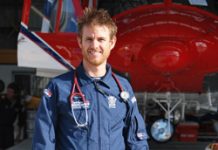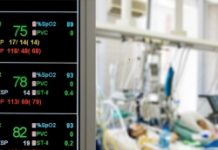 Welcome to my A&E Department. Local population: 10 to 100 (dependent on the season). Staff: 1. Nearest referral hospital: 2800 miles (but no referral, transfer or evacuation possible for 8 months each year).
Welcome to my A&E Department. Local population: 10 to 100 (dependent on the season). Staff: 1. Nearest referral hospital: 2800 miles (but no referral, transfer or evacuation possible for 8 months each year).
Welcome to SANAE IV Antarctica – my home for 15 months and the current year round research station of the South African National Antarctic Expedition.
South Africa is one of approximately 20 countries which maintain yearround stations in Antarctica, using the unique conditions as a massive laboratory for research. Nothing in Antarctica is simple however. Research teams across the continent, which is 56 times greater than the UK in surface area, have to contend with living in the harshest environment on Earth.
Antarctica is the coldest place on the surface of the planet with temperatures dipping towards -90°C near the South Pole; the windiest, with hurricane force winds an almost weekly phenomenon; the highest, averaging 1860m (6100 ft) above sea level; and despite having more than 70 percent of the planet’s fresh water trapped as 97 percent of the world’s ice, it is the greatest desert with the Dry Valleys area of Antarctica having not seen precipitation in millions of years.
In the frigid darkness of the austral winter the sea around the continent freezes for hundreds of miles doubling the surface area of ice. Less than 1000 people are to be found on the entire continent in winter scattered amongst the isolated research stations like tiny candles in the perpetual darkness. During summer this number swells to somewhere over 4000 as the influx of summer field researchers, support and logistics personnel and a rapidly increasing number of tourists (more than 40,000 in the last year) head south to enjoy the fine weather (‘barely’ subzero) and long hours of sunlight.
Stations near the pole experience six months of perpetual darkness during winter and are completely isolated from the rest of the world. Flying into Antarctica in the winter is a near impossibility and it has been suggested that it is logistically simpler to evacuate a casualty from the International Space Station than from Antarctica at this time of year. While many would find providing medical care in this environment incredibly daunting, for a handful of adventurous medics it is a dream come true.
The Antarctic A&E Department
 ‘My’ A&E department consists of three main rooms. A consulting room/office is equipped with the usual items: examination table, basic diagnostic equipment, computer, and modest medical library in a bookshelf. An interconnecting door leads to the clinic area which contains a single hospital bed with non-invasive monitoring.
‘My’ A&E department consists of three main rooms. A consulting room/office is equipped with the usual items: examination table, basic diagnostic equipment, computer, and modest medical library in a bookshelf. An interconnecting door leads to the clinic area which contains a single hospital bed with non-invasive monitoring.
A mobile x-ray machine allows me to perform plain films, which I develop by hand in an adjoining darkroom.
Across from the bed is my ‘lab’ which consists of a centrifuge, light microscope and all the paraphernalia to perform smears and cell counts. We are also lucky to have a test strip based machine to perform basic blood chemistry, although unfortunately not blood gases. A small autoclave allows sterilization of equipment.  The other corner of the room is dedicated to dental work with a full-sized dentist’s chair, small instrument platform powered by a portable compressor and a mobile suction unit.
The other corner of the room is dedicated to dental work with a full-sized dentist’s chair, small instrument platform powered by a portable compressor and a mobile suction unit.
Leading off from the clinic area is the operating theater which doubles as a resuscitation room. Although austere, there is a basic operating table, a no-frills anesthetic machine (with one vaporizer containing halothane!), non-invasive monitoring and wall gases (oxygen and nitrous oxide). Suction is provided by mobile units and the dental light is used for additional illumination.
The Antarctic General Practice
Most expeditions favour a doctor with some surgical experience, particularly with an emphasis on trauma, along with good general practice and general medicine knowledge. Participants in the expeditions are usually very thoroughly vetted prior to departure but still the majority of the medical case load is similar to a general practice.
Minor respiratory and GI tract ailments are common. In addition, bumps, scrapes and scratches are regular occurrences. Psychological problems as a result of the isolation and physiological disturbances of working in such an unusual environment for long periods are frequent. Sleep disturbances due to the perpetual daylight in summer and darkness in winter are the most ubiquitous diagnosis.
Contrary to expectations cold injuries such as frostbite, hypothermia and other environment-specific illnesses like snowblindness are rare because of the prominent educational programs for expedition staff. The most prevailing concern is that of significant trauma through ice-related falls or injuries from cargo handling – hence the preference towards doctors with good trauma experience. Other ‘peripheral’ skills of value on the continent are experience with disaster planning and mass-casualty incidents, aeromedical skills and the ability to use outside assistance via forms of telemedicine successfully.
Meningitis at minus 40
Famously, a Russian doctor removed his own appendix under local anesthesia at the Novolazarevskaya base about 300 miles from SANAE IV using various teammates as assistants. It helps to demonstrate how the expedition doctor in Antarctica has to be many things at the same time and requires the skills of an A&E doctor, general practitioner, psychologist, surgeon, anaesthetist, radiographer, dentist, pharmacist and laboratory technician.
Most expeditions include pre-departure training which addresses these needs – particularly the ancillary roles which are not part of most doctors’ experience such as dental work and taking and developing x-rays. Doctors with an A&E background are good candidates for this type of work where excellent diagnostic skills and a broad understanding of the full spectrum of disease can fill the void created by the absence of advanced imaging and laboratory investigations.
For example, the most serious illness I have faced during this expedition occurred when a team member developed clinical signs of meningitis a few days after evacuation of a minor dental abscess. Assisted by a diesel mechanic as my ‘nurse’, I made the diagnosis on clinical grounds then performed a lumbar puncture and started empiric treatment. In the lab using the centrifuge, microscope and some basic equipment I was able to establish a raised white blood count and erythrocyte sedimentation rate.
I then performed a CSF stain and identified Staphylococcus as the pathogen. The patient recovered rapidly on the appropriate treatment. The episode reinforced my belief that as doctors we should not allow ourselves to become distanced from clinical and laboratory procedural skills such as microscopy that form an integral part of acute medicine.
SANAE IV
 As suggested by the name, this is the fourth SANAE base. The first three were built on the ice shelf and were gradually buried by snow and crushed in the ice which forced them to be decommissioned. To escape this fate, SANAE IV was built inland atop a nunatak (mountain peak projecting through the ice cap) known as Vesleskarvet in the Queen Maud Land region.
As suggested by the name, this is the fourth SANAE base. The first three were built on the ice shelf and were gradually buried by snow and crushed in the ice which forced them to be decommissioned. To escape this fate, SANAE IV was built inland atop a nunatak (mountain peak projecting through the ice cap) known as Vesleskarvet in the Queen Maud Land region.
Several other nations have bases in this area. The German research station, Neumayer II, and Norwegian station, Troll, are to be found about 125 miles west and east of SANAE.  Despite these ‘neighbours’, we are essentially isolated as to make an overland voyage to either station is a journey fraught with danger from crevasses and severe weather conditions. During the brief summer, however, the base population swells from 10 to nearly 100 persons and a local air network is established to move personnel and supplies. As a central location, SANAE is equipped with a larger than average medical facility in order to provide medical support.
Despite these ‘neighbours’, we are essentially isolated as to make an overland voyage to either station is a journey fraught with danger from crevasses and severe weather conditions. During the brief summer, however, the base population swells from 10 to nearly 100 persons and a local air network is established to move personnel and supplies. As a central location, SANAE is equipped with a larger than average medical facility in order to provide medical support.
The White Continent
Antarctica is without doubt the most beautiful place I have ever been. Even when the temperature is forty below zero it is a privilege to walk around the mountain or simply sit and listen to the ice crack as the glaciers move imperceptibly onwards. The frequent storms bring both terror and wonder, as the winds scour the landscape and static electricity sparks on every surface. The light is forever changing and it appears as if the stars are so close that one can almost touch them.
Simply to journey to Antarctica truly takes one beyond expectations, beyond normality and into that place that ‘transcends reason’. Although not suited to everyone, to be able to use your career as a vehicle to see the White Continent in all her moods is an opportunity beyond your greatest dreams.
You can follow Dr Ross Hofmeyr’s Antarctic journey at www.doctorross.co.za.
Images used courtesy of (c) Dr Ross Hofmeyr unless otherwise stated. This article first appeared in the Association of Emergency Physicians First Line Newsletter Vol. 5, Issue 3, Fall 2008 www.aep.org



































